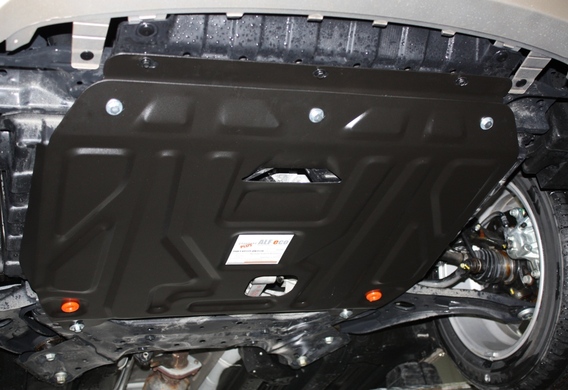
The bottom of the car is the most unprotected body. However, in the front of the body, vital parts are hung directly above the road, unsecure. The practice of using a car in "far from greenhouse" conditions has revealed the need for a solid and rigid plate protecting the bottom of the subsurface area. Lower engine manufacturers ' efforts to protect the engine compartment
Lower engine manufacturers ' efforts to protect the engine compartment
To some extent, the motor compartments of all modern vehicles are protected from water, mud and flying stones. If you look at the bottom of the subspace, in most cases you can see the plastic composite protective cover located at the bottom of the subsurface.
If you are suspected of deformation, the shape of the crankcase steel should be restored immediately. There are cases in which the curved protection extended the pallet of the crankcase to the hole
Moreover, some models, such as the Renault Logan, already at the plant place steel protection of the crankcase in the framework of adaptation to the peculiarities of the roads in Russia. If you are going to buy any other car for an official dealer, you will almost certainly offer protection as an option.
Main protection requirements for crankcase
Any additional detail to be installed on a modern car must comply with a number of requirements. On the one hand, it is desirable that in the case of an obstacle the only protection is deformed without the pallet of the crater. Therefore, it must be rigid. On the other hand, undue detail in the collision may disrupt a complex system of passive body safety. The protection shall be attached to the tenor parts of the body which, in the event of an accident, shall be deformed according to a given scenario and may interfere with the deformation. The exit was found in the selection of the creeped. Although the protection is used as a rule heavy and solid steel sheet, the bolts to which it is attached to the bodywork are collected in such a way that in the event of an accident, the defense cut their hats and go down, under the bottom, without preventing the engine from being displaced on a given trajectory.
One of the strongest composite materials for the construction of crankcase protection-Kevlar-is also used in the production of flak jackets
The composite impact protection should be broken, as well as allowing the engine to move down (rather than get into the salon, as in old cars). In the case of an obstacle, bolts remain in place, and the protection is deformed in the place where the foreign object falls.

For the installation of the protection only the qualitative elements of the anchorage and the permanent holes in the body parts shall be used. In no case may new openings be removed from the force elements.
After installation, the protection should not interfere with the maintenance and diagnostic examination of the vehicle. Therefore, its design includes a special hole to replace the oil filter and the oil drain, and the additional holes contribute to the engine's consideration and help to maintain the optimal thermal conditions of the engine.
Travelers in cross-terrain vehicles often "extend" the protection of the crankcase to the rear bumper
Corrosion resistance of crankcase protection is equally important. The bottom of the vehicle is exposed not only to moisture, dirt, but also to chemical reagents used for road processing. The protection of composite materials, as well as aluminium rust, is not scary. In the manufacture of steel, they are covered with powder paint or polymer coating, resistant to aggressive media.
Crankcase protection design
Most often, the protection of the crankcase is a steel or aluminium sheet, which is attached to a certain form by the press. The steel protection has a thickness of 1.5 to 3 mm, aluminium ranging from 2 to 5 mm.
Some constructs include additional elements: stiffness ribs, stamping. Special rubber cushions or vibrations eliminate vibration and vibration.
In recent times, composite protection has been particularly popular on the market. They are 1.5 times lighter and more solid steel, and they reproduce the geometry of the crater, as complex forms in the production technology of composite parts are easier to reproduce.
Advantage and disadvantages of various types of protection
The most common is the protection of the oil crankcase from steel. It is reliable and resistant to impact. Thanks to the coatings, the steel is free of corrosion, and it's cheaper. But this feature significantly increases the weight of the front of the car, so buyers are increasingly giving preference to aluminum products.
When replacing the engine oil, it is recommended that the engine be removed even if there is a hole in the protection. The thing is, the oil flowing down is pretty unpredictable.
Aluminum protection is easier, but always thicker (this is related to the specific properties of the metal). The weight of such protection is 7 to 9 kg, which is 20-30% less than that of steel. Aluminium parts are reliable enough, more attractive, but also cost twice as much as for steel.
The most solid and most expensive is the composite protection of the engine's crankcase. Its advantages are absolute corrosion resistance and low weight.
The undoubted dignity of composite protection is that after the impact it is practically not deformed (naturally, up to certain limits by force of influence), that is, there is no subsequent contact with elements of the engine compartment of the vehicle leading to their wear.
On the market of spare parts the buyer can choose from a wide range, and even the most demanding car owner can easily choose the protection that will most closely match all of its requirements.







